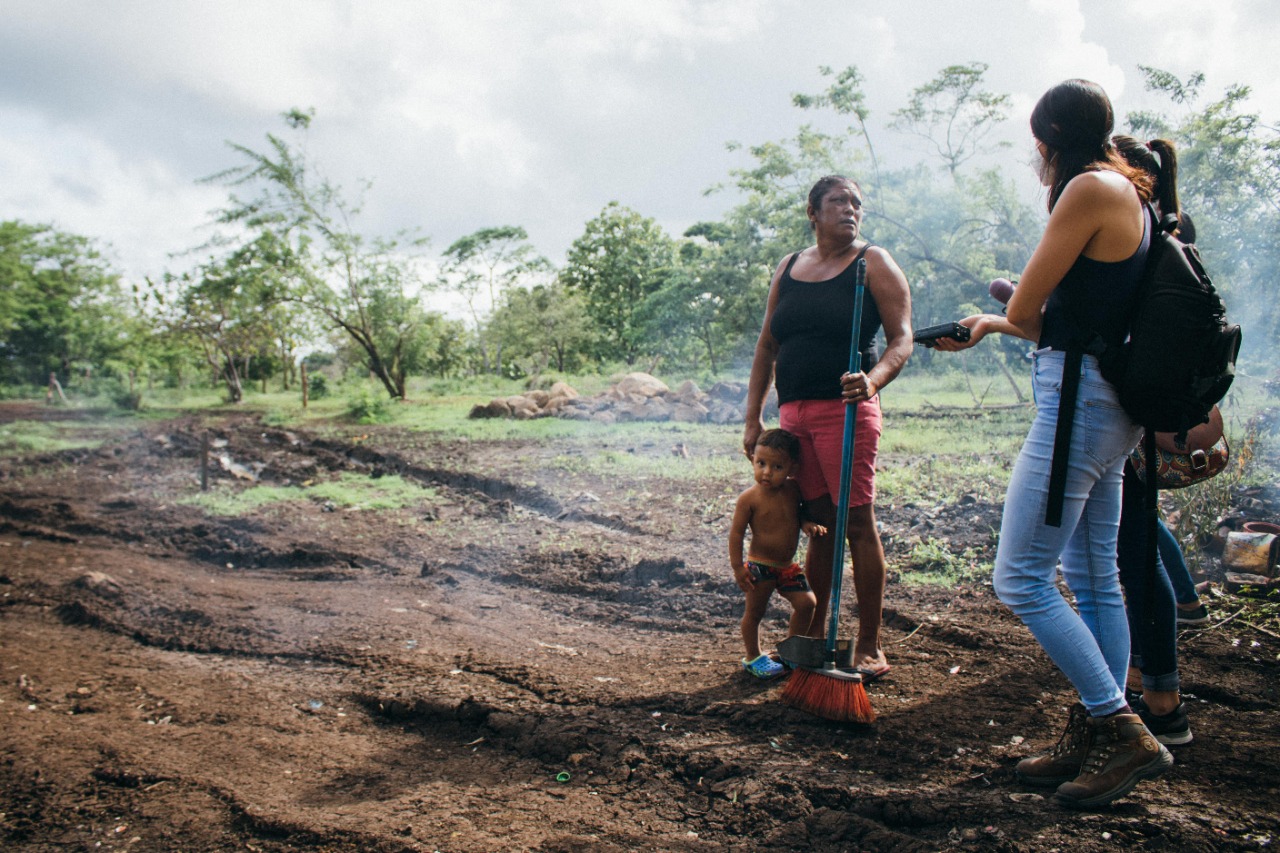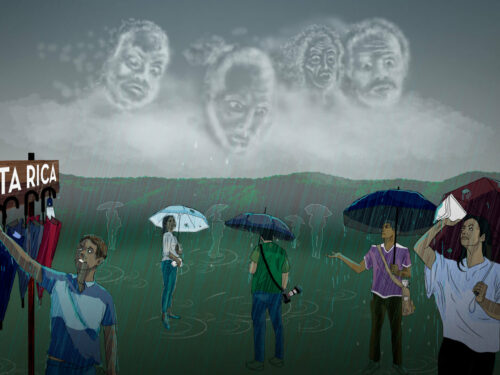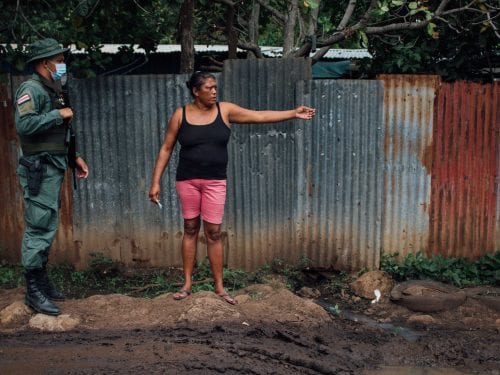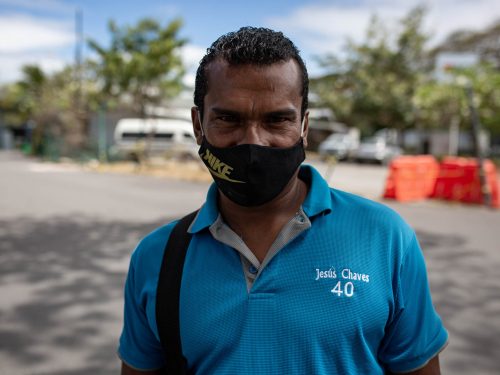
The COVID-19 pandemic arrived and people looked for someone to blame. In Costa Rica, amid a second wave of cases that is growing exponentially, one of the parties frequently pointed to as the responsible one is the Nicaraguan immigrant community. Xenophobia against them has increased.
In a country of five million inhabitants, of which almost half a million are of Nicaraguan origin, expressions of xenophobia are nothing new. However, in the context of the health crisis, many comments on social media and in daily conversations point the finger at the “Nicas”, who cross the border at unmarked crossings and bring the virus with them.
Others accuse those living in the tenement rooms of the capital city of San Jose. Living in close quarters, these impoverished immigrants infect each other, causing a cascading increase in the city’s cases. Until July 13, the total number of cases amounted to 8036, out of which 2370 were foreign people, that is, 29.49%.
La Voz de Guanacaste and Interferencia by Radioemisoras UCR, together with CONFIDENCIAL in Nicaragua, organized a virtual talk on the increase in xenophobia in Costa Rica and how to counteract it. This effort is part of the La Frontera Dibujada (“The Drawn Border”) investigation, in which our binational journalistic team visited eleven points on the border between Nicaragua and Costa Rica to paint a verbal picture of how the border towns are experiencing the pandemic. Increased xenophobia was one of the recurring topics of conversation among the subjects interviewed.
Cynthia Castro, a psychologist specializing in human behavior, and Carlos Sandoval, a researcher specializing in migration at the University of Costa Rica (UCR), were interviewed by journalists María Fernanda Cruz, editor of La Voz de Guanacaste, and Hulda Miranda, a journalist from the Interferencia radio show.
We all have biases
Cynthia Castro began by explaining that all people have biases, either explicit or implicit. What changes with the pandemic, she added, “is the social permission to express them.”
In Costa Rica, we see more people today “verbalizing that prejudice towards certain populations.”
Prejudices towards migrants are not new but during the pandemic, there is a social justification to express them, she said. In addition, virtual platforms such as social media increase the degree of aggressiveness with which people manifest their anger and fear.
Sandoval exposed the historical reasons that lie behind the rejection of foreigners. The concepts of migration and migrants came with the decision of States to create borders to determine their sovereignty. Paradoxically, he said, it is in border towns where these concepts are least important.
“Where the line is crossed it is so arbitrary that, ironically, it has more relevance in the political centers of the countries than in the geographical areas called borders,” Sandoval explained.
This is also supported by the people interviewed for the investigation, who are part of cross-border communities. They lived there without distinguishing the border between Nicaragua and Costa Rica until the pandemic drew a line that interrupted their daily routine.
Do I reject poor people?
In Costa Rica, as in other countries, society establishes “categories” within the foreign population residing in the country. There are “expats”, “investors” and migrants. The latter are “nicas”. Not all of them, especially the poor ones. This was explained by Sandoval when asked about the relationship between immigrants rejection and discrimination against poor people.
Not all foreigners are perceived in the same way. “Costa Rica, in relative terms, has one of the highest percentages of American people with respect to the total of Costa Rican people who live here, but that American who lives in the North Pacific is called ‘investor’,” he argued.
It is a very selective notion that has to do with social class, skin color … “There are some Nicaraguans who “are not nicas”, if we take into consideration the stereotypes, such as Cervantes Prize-winner and writer Sergio Ramirez, or the very-prominent-journalist Carlos Fernando Chamorro.
The concept of migrant “is a selective term and has a face of poverty,” he assured.
Beware of discourses
During the conversation, Castro and Sandoval also talked about the importance of government and media narrative when managing the pandemic. Castro warned of the danger of speaking of “the war against coronavirus.”
“When they talk about war, people need to find someone to blame. There is an enemy in war and here we are facing a virus, which is invisible, it is something too abstract… We fall into situations where, for example, instead of being outraged by the social and economic inequality that exists in flophouses, what we do is turn the people who live in the flophouses into the enemy,” Castro explained.
“Secondly, war requires action, it requires fighting against someone. On a psychological level it is very complicated when we are told to stay home, to be passive when facing a war,” Castro added.
The psychologist also warned that, in a pandemic situation, the protection of the tribe discourse increases fear of the other and the need to blame them for all the problems that occur.
Instead, she recommended the use of the “journey” metaphor, viewing the pandemic as the journey that requires teamwork, as opposed to the war metaphor where there are winners and losers.
How to distinguish between data and xenophobia?
The Ministry of Health provides the epidemiological report of the coronavirus situation in Costa Rica daily. In this report, a distinction is made between cases in national and foreign persons. Sandoval explained that, from an epidemiological point of view, there is a traceability reason, to track outbreaks (and differentiate them in this way).
However, that distinction can also be used in a “deliberatively hostile and aggressive” manner. Although the percentage of the Nicaraguan population living in Costa Rica is less than 10% and the percentage of foreigners infected with coronavirus reaches 30%, Sandoval pointed out that “there is a reality that deserves an explanation. Behind that 30%, there is a huge inequality that we can’t even name. The question is why they have tested positive. ”
Among the multiple reasons, Sandoval highlighted the “enormous irresponsibility” of the Daniel Ortega government in Nicaragua, which not only has it not adopted physical distancing measures, but it has also promoted mass events.
On the other hand, he brought up “the irresponsibility of some companies in the export agriculture sector that have assumed that they need workers and do not care about human beings. You have to fill the container that goes to Brussels, Amsterdam … and there goes the fruit, the pineapple for which Costa Rica is now famous, along with coffee and bananas … and the rest is not important”.
We need an alternative narrative to xenophobia, such as the notion of interdependence of the two nations by geography, history, economy, Sandoval added. “11% of the gross domestic product is produced by Nicaraguans. With the coffee harvest, the question of recognizing that we need those we reject will open up to us, ”he said, referring to the need for more than 70,000 foreign collectors that Costa Rica will soon need to harvest different products.
Is xenophobia curable?
It is difficult to break prejudice when there is no openness to listen to the data, Castro said. People don’t follow the data as much as they follow stories. “Just one story of a migrant person committing a crime is enough to make the generalization.”
“There are many myths about the Nicaraguans that have been already fact-checked, but there are people who won’t listen. Due to our biases, we only consume information that confirms those biases,” she added.
“Humanizing these people, who are often stereotyped, and telling their stories can help dismantle those prejudices,” she said.
“We are not as rational as we think. The invitation is for all of us to become aware we have biases,” she stressed.
Nicaraguan migrants in the Costa Rican social imaginary
For Sandoval, migration needs to be discussed and made more visible in more social areas and not only in academia. “I am intrigued that we still don’t have a novel on migration, for example, the one the eighth-grader is going to read.”
Contributions must come from different sectors. “We need a different language from the private sector, from the churches …”. Sandoval lamented the distant position of the Catholic Church on these issues and that in neoconservative Christian groups there are those who care a lot about life “at conception”, “but once life is born, they care very little”.
Castro agreed on the need to humanize the migrant community. It is important that through the media we generate contact, make them visible, reach people’s emotions. “How many foreigners will there be right now working in hospitals, for example, or in guaranteeing the country’s food security? (Those stories) are more likely to challenge people’s biases, more than presenting them data or having them participate in workshops.,” she explained.
In order to eliminate xenophobia, Sandoval also considered it important for the Costa Rican society to recognize that this hostility exists and goes back a long way. This xenophobia “has increased since the Sandinista Revolution of 1979. This is 40 years old … There was a discussion 25 years ago about whether cholera was transmitted in Costa Rica by Nicaraguans …”
“An irony of Costa Rican society is that we say it is a peaceful one, but it has great authoritarian and aggressive potential. It is a characteristic that you have to pay close attention to,” he warned.
“We need to reinvent the sense of nationality. We have this idea that we are homogeneous and exceptional … We are taught, not consciously, to not talk about our Nicaraguan origins. There are so many binational families, those stories, that’s not talked about. The idea that we are homogeneous is reinforced, when, in reality, we are a society that has changed a lot,” he argued.
What can Nicaraguans do?
For both specialists, this was one of the most difficult questions to answer.
Castro pointed out that the Nicaraguan community in Costa Rica has the right to be outraged by a xenophobic attack, but she invited them to distance themselves from it. “Hopefully they can be the ones who build bridges instead of contributing to conflict. They have no obligation to educate the other person, but it is best to take a further perspective at a distance. ”
Sandoval advised to work on the story of brotherhood. “It is not about vindicating Nicaraguan nationalism, as Arnoldo Alemán said ‘the San Juan river is Nicaraguan’,” but rather about recognizing what we have in common,” he concluded.







Comments